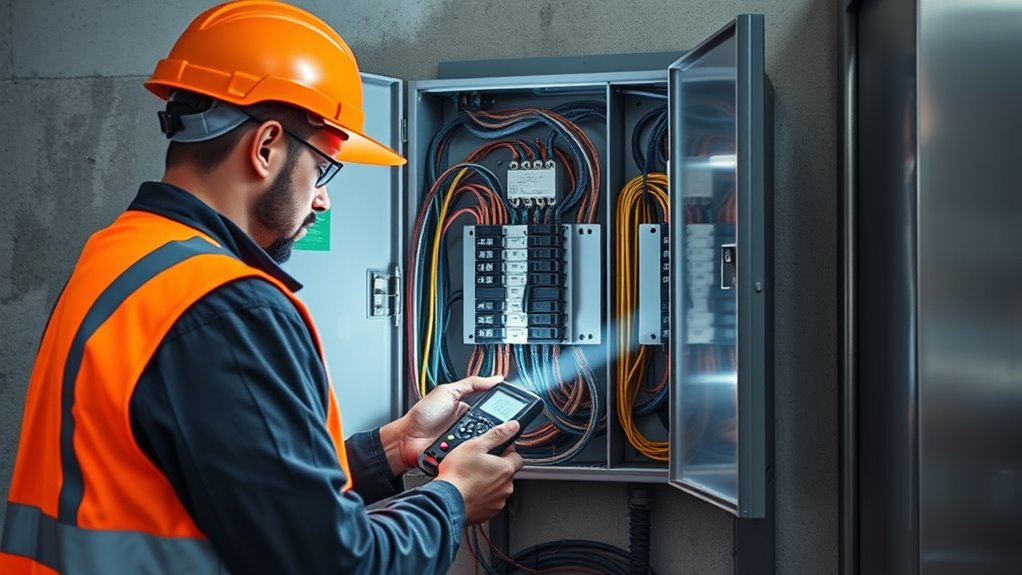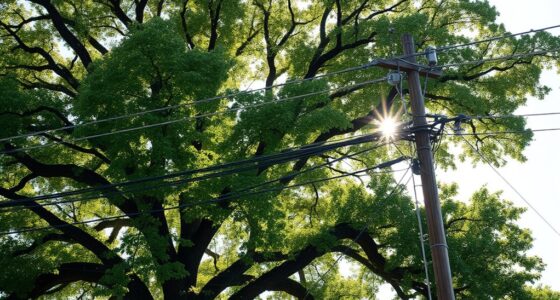After a power outage, start by inspecting your home for hazards like sparks, smoke, or burning odors, and turn off appliances to prevent damage. Check your circuit breakers and fuse boxes for tripped breakers or blown fuses, resetting them safely if needed. Test outlets and cords for damage and verify they work properly. Follow safety precautions, like wearing insulated gloves and turning off main power before any resets. For more tips on keeping your system safe and up to code, continue exploring.
Key Takeaways
- Check for visible damage like scorch marks, melted wires, or broken outlets before restoring power.
- Inspect circuit breakers and fuses, resetting or replacing them as needed to restore proper function.
- Ensure safety by turning off appliances, using insulated tools, and verifying circuits with testing tools.
- Perform regular maintenance, including inspecting wiring and grounding, to prevent future outages and hazards.
- Contact a licensed electrician if you detect electrical odors, damage, or persistent issues despite troubleshooting.
What Are the First Steps to Take After a Power Outage?
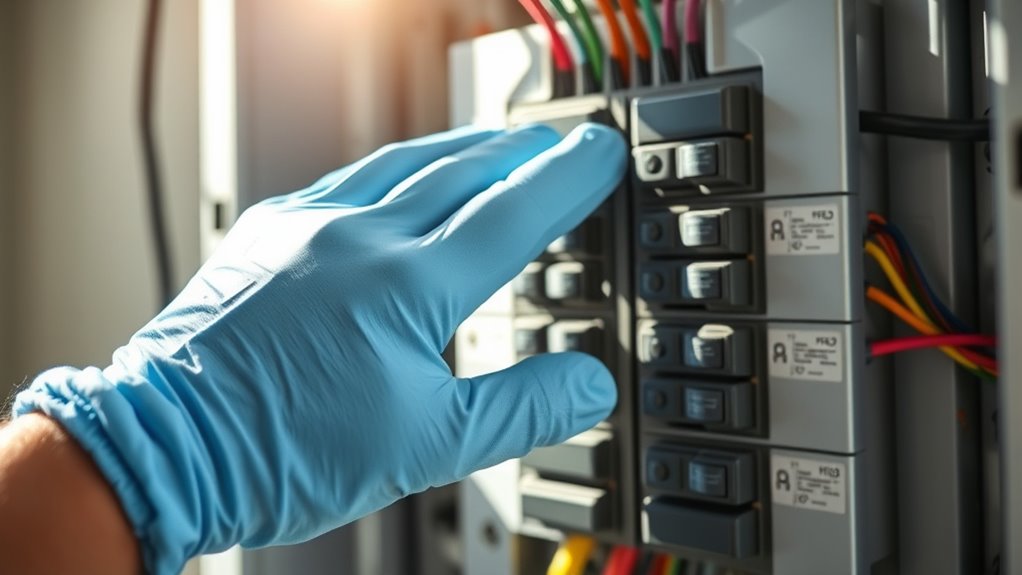
After a power outage, the first thing you should do is make sure everyone is safe and check for any immediate hazards, such as downed power lines or sparks. Once safety is confirmed, avoid plugging in devices until you’ve assessed the situation. Power surges can occur when the electricity is restored, potentially damaging your appliances or electrical system. It’s a good idea to perform some basic electrical maintenance now—inspect cords and outlets for damage. If you notice any signs of trouble, consider calling a professional electrician. Taking these initial steps helps protect your home and prepares you for a safe power restoration. Remember, rushing to use appliances without checking can lead to further electrical issues or hazards. Additionally, performing post‑outage electrical checks can help identify potential problems early and prevent further damage.
How Do I Check My Circuit Breakers and Fuses?
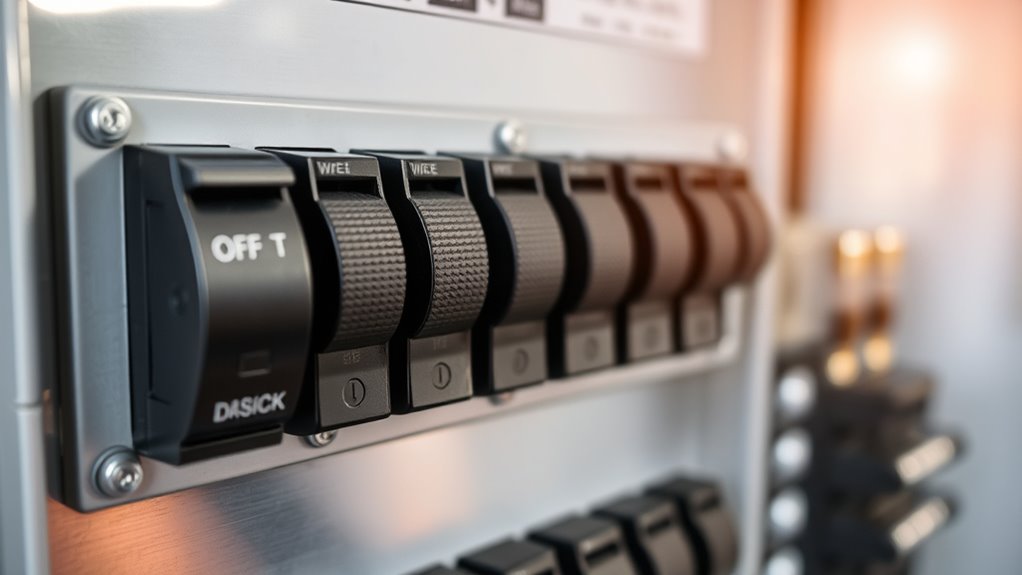
To guarantee your electrical system is functioning properly after a power outage, start by checking your circuit breakers and fuses. Begin with circuit breaker testing by locating your panel and inspecting each breaker. If a breaker has tripped, it will be in the off position or middle position. Reset it by flipping it fully off, then back on. For fuse inspection, examine each fuse for signs of damage, such as a broken filament or a blackened appearance. Replace any blown fuses with new ones of the same type and rating. Always make sure the power is turned off before handling fuses or resetting breakers to avoid shocks. Performing these simple checks helps confirm your electrical system is safe and operational before restoring power to your appliances. Additionally, ensure your electrical safety measures are up to date to prevent future issues.
What Signs Indicate Electrical Damage or Hazards?
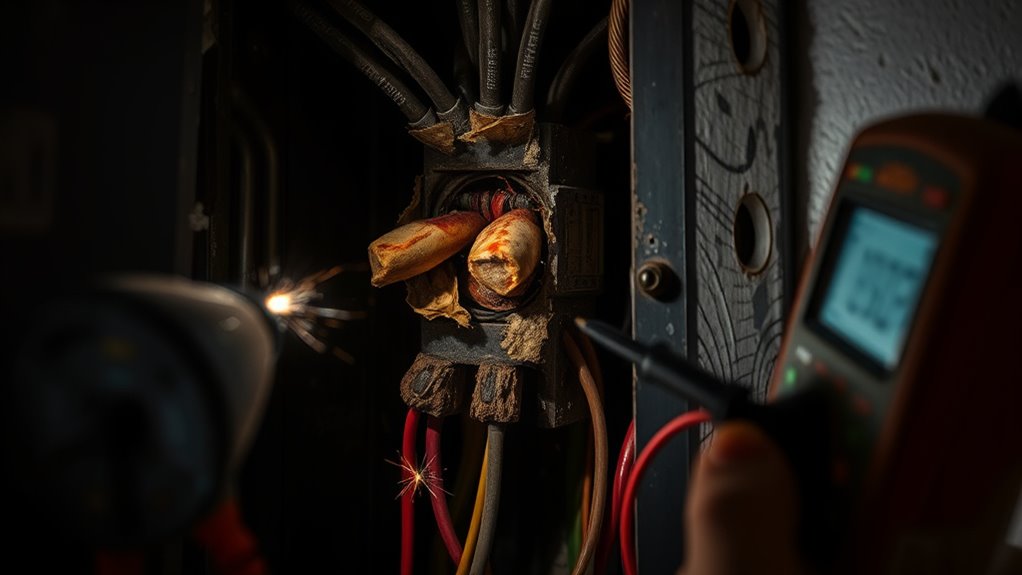
You should watch for visible damage like scorch marks, frayed wires, or broken outlets. Unusual electrical behavior, such as flickering lights or frequent breaker trips, also signals potential hazards. Recognizing these signs early helps prevent further damage or safety risks. For comprehensive safety, consider consulting a professional electrician to assess your electrical system.
Visible Damage Signs
What visible signs might indicate electrical damage or hazards following a power outage? Look for visual damage such as scorched outlets, melted wires, or burn marks on panels. Discoloration or charring around switches and circuit breakers also signals potential issues. Cracks or broken insulation expose hidden faults that could lead to shorts or fires. If you notice any melted or deformed components, avoid touching them and consider turning off the power. Loose connections may not be visible but can cause arcing, which sometimes leaves scorch marks or blackened areas. Always inspect for signs of smoke or unusual odors, as these can indicate internal damage. Recognizing these visible damage signs helps prevent further hazards and ensures your electrical system’s safety after a power outage. Additionally, electrical safety protocols emphasize the importance of timely inspections and professional assessments to prevent accidents.
Unusual Electrical Behavior
Unusual electrical behavior often signals underlying damage or hazards in your system. If circuits trip unexpectedly, outlets feel warm, or lights flicker, it could indicate grounding issues or damaged wiring. These signs suggest your system isn’t properly grounded, risking shock hazards or equipment damage. Additionally, if your surge protection devices don’t activate during a storm or power spike, your system might be vulnerable to surges that cause electrical damage. Unexplained buzzing noises or burning smells near outlets are also warning signs of serious problems. Addressing these issues promptly helps prevent dangerous faults and protects your appliances. Always inspect your grounding connections and ensure surge protection devices are functioning correctly. Recognizing these signs early can save you from costly repairs and safety hazards. Sometimes, unexpected behaviors can also be caused by faulty or outdated wiring that needs professional attention.
How Can I Test My Outlets and Appliances for Proper Functioning?
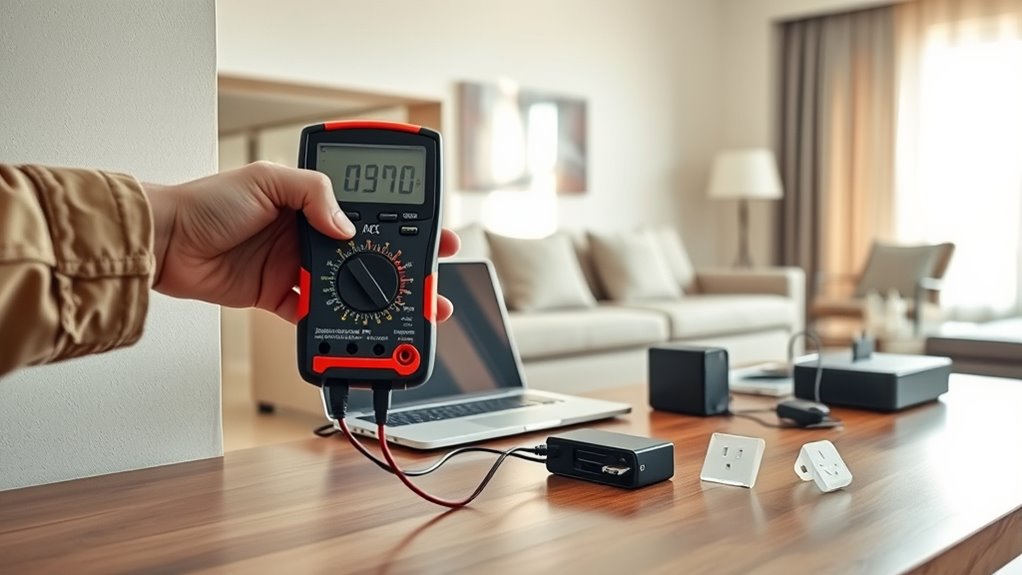
Wondering if your outlets and appliances are working properly after a power outage? Start by performing simple circuit testing with a voltage tester or outlet tester to verify outlets are providing power. Check each outlet in different rooms to identify any that might be dead. For appliances, inspect plugs and cords for visible damage, and plug them into a known working outlet to test functionality. Turn appliances on and observe their operation. If an appliance doesn’t power on or behaves abnormally, consider doing a thorough inspection or testing with a multimeter if you’re comfortable. Remember, consistent testing helps identify issues early and confirms that your electrical system is functioning correctly after the outage. Additionally, ensuring your remote work setup is functioning properly can help you maintain productivity during recovery.
When Is It Necessary to Call a Licensed Electrician?
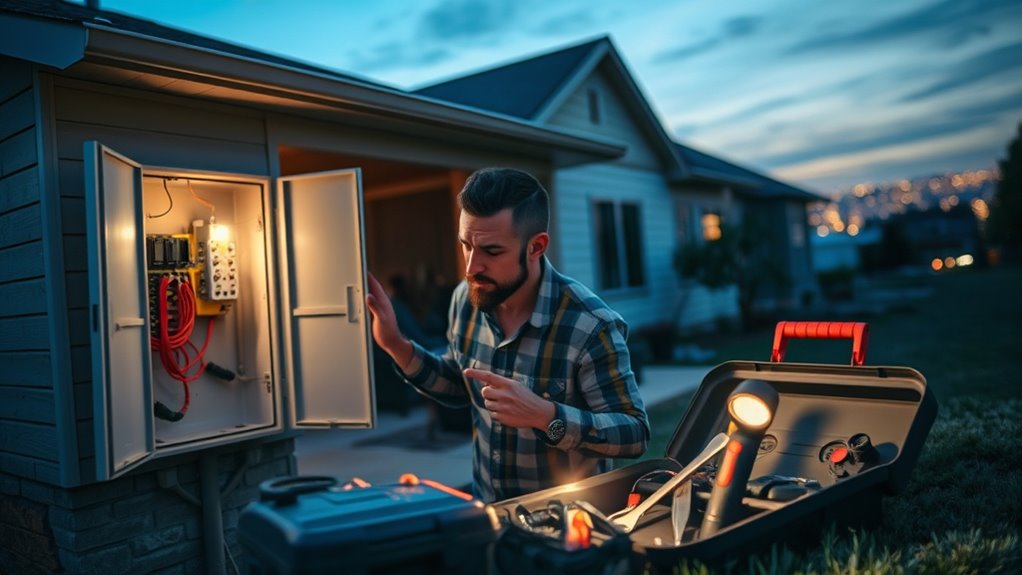
If you experience persistent power failures, it’s time to call a licensed electrician. Unusual electrical odors or visible damage or wear should also prompt professional help. Recognizing these signs guarantees your safety and prevents further electrical issues. Additionally, performance cookies can provide valuable data to help identify underlying electrical problems.
Persistent Power Failures
Persistent power failures can be a sign of underlying electrical issues that require professional attention. If your home repeatedly loses power despite a recent outage, it’s time to contemplate calling a licensed electrician. They can assess whether your surge protection devices are functioning properly or if your backup generators need repair or replacement. Additionally, it’s important to recognize electrical system warning signs, which can indicate deeper problems that require expert evaluation. You should contact an electrician if you notice:
- Frequent outages that disrupt your daily routine
- Damage to appliances or electronics during power restoration
- Signs of electrical overload, like flickering lights or tripped circuit breakers
Addressing these issues promptly ensures your electrical system is safe and reliable. Don’t delay professional help—persistent failures often point to deeper problems that only a trained electrician can resolve effectively.
Unusual Electrical Odors
Unusual electrical odors are a clear warning sign that something may be wrong with your home’s wiring or electrical components. If you notice electrical smells, don’t ignore them. These odors can come from various odor sources, such as overheating wires, damaged insulation, or faulty outlets. When you detect a burnt or chemical smell, it’s essential to act quickly. Turning off your main power supply and avoiding contact with electrical fixtures is a wise step. If the smell persists or worsens, it’s time to call a licensed electrician. They can safely identify the source of the electrical smells, inspect your system, and prevent potential fire hazards or further damage. Never delay professional help when dealing with unusual electrical odors. Additionally, understanding the role of contrast ratio in projectors can help improve your home cinema setup and ensure optimal viewing conditions.
Signs of Damage or Wear
Knowing the signs of damage or wear in your electrical system is crucial for safety. If you notice frequent power surges, circuit overloads, or flickering lights, it’s time to call a licensed electrician. These issues may indicate underlying problems that can lead to electrical failures or fire hazards. Specifically, look for:
- Repeated circuit trips or blown fuses
- Burn marks or scorch marks on outlets or switches
- Unusual noises or a burning smell near electrical components
- Proper maintenance can help prevent these hazards and extend the lifespan of your electrical system.
Power surges can damage sensitive devices and signal wiring problems, while circuit overloads strain your system, increasing risk. Addressing these signs promptly by consulting a professional ensures your electrical system remains safe and reliable, preventing costly repairs or accidents.
What Safety Precautions Should I Follow During Inspection?
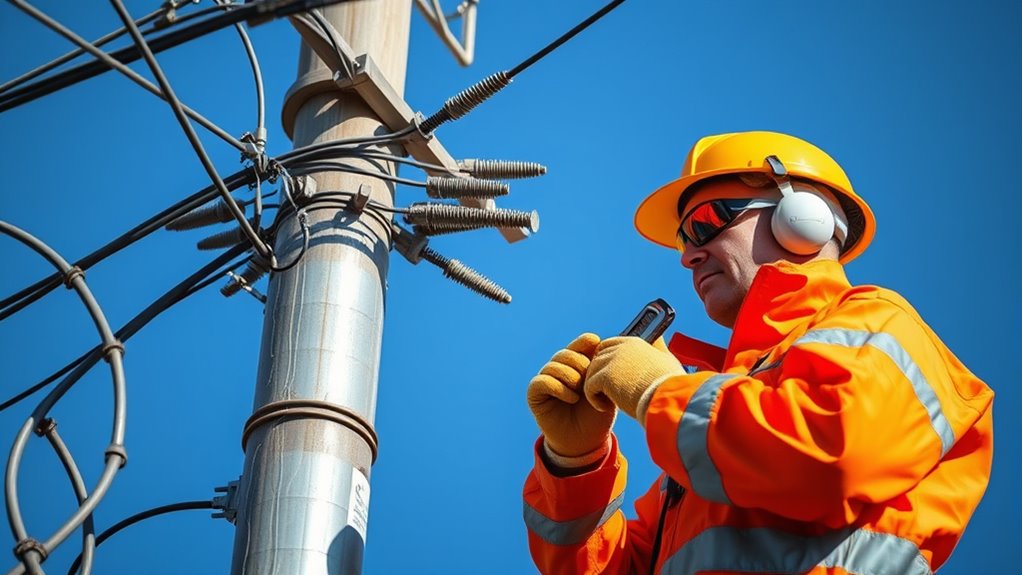
When inspecting electrical systems after a power outage, safety should be your top priority. Always wear appropriate personal protective equipment (PPE) like insulated gloves, safety glasses, and non-conductive footwear to prevent injuries. Be sure you’re prepared with emergency preparedness plans in case of unexpected hazards. Use this table as a quick safety reminder:
| Precaution | Action |
|---|---|
| Confirm power is off | Turn off main breaker before inspection |
| Avoid wet conditions | Do not inspect with wet hands or in damp areas |
| Use insulated tools | Prevent accidental electrical contact |
Following these precautions reduces risk and keeps you safe during inspections. Remember, safety always comes first.
How Do I Reset or Restore Power Safely?
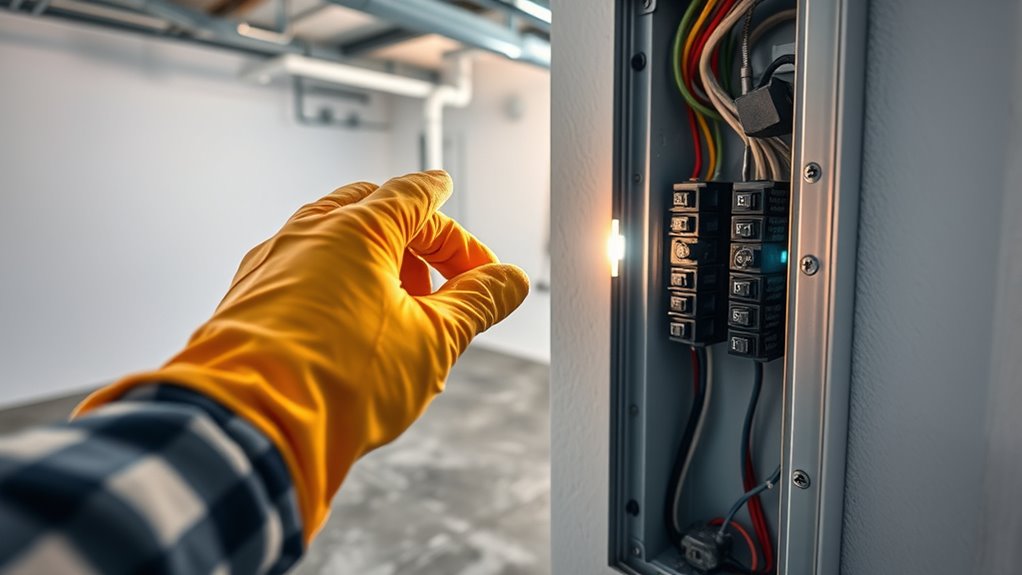
Before restoring power, verify that all safety precautions are in place. Confirm circuits are properly tested, and confirm that surge protectors are correctly installed to prevent damage. To reset safely:
- Turn off all appliances and electronics to avoid overload.
- Reset the circuit breaker by switching it to the off position, then back to on, after confirming no faults.
- Use circuit breaker testing tools if needed to verify proper functioning before restoring power.
Always inspect surge protector use to ensure they are in good condition, and avoid overloading outlets. Do not rush the process; double-check connections and safety devices to prevent future issues. This careful approach minimizes risks and ensures a safe power restoration.
What Preventative Measures Can Help Minimize Future Outages?
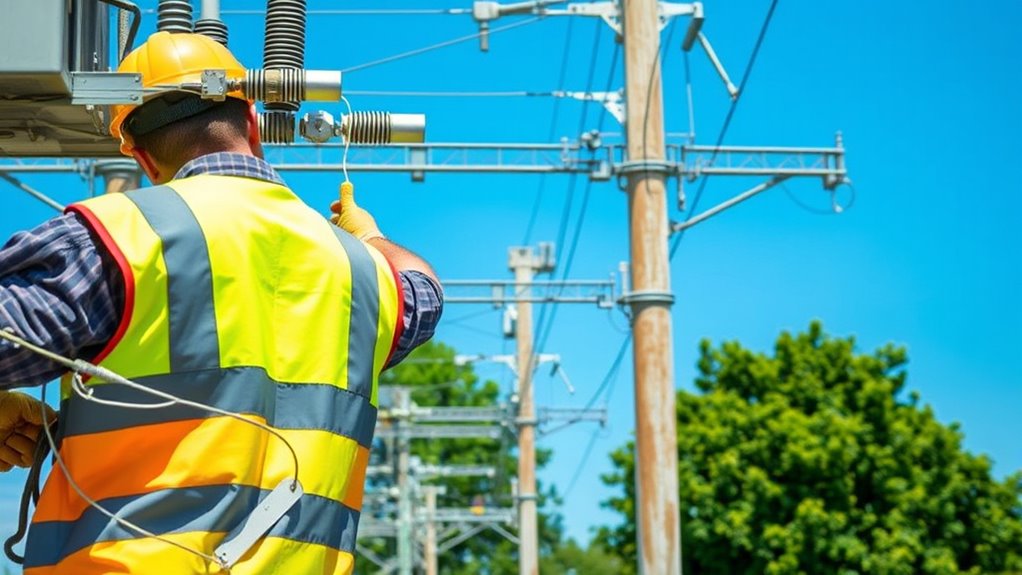
Implementing regular maintenance and inspections of your electrical system can substantially reduce the risk of outages. Preventative maintenance helps identify potential issues before they cause failures, ensuring your system runs smoothly. Keep an eye on worn-out wiring, loose connections, and outdated components, and address them promptly. Installing surge protection devices is another key preventative measure, shielding your system from voltage spikes caused by storms or grid fluctuations. These devices help prevent damage to your appliances and electrical infrastructure, reducing the likelihood of outages. Additionally, maintaining clear access to electrical panels and ensuring proper grounding can prevent faults. By proactively managing your electrical system with preventative maintenance and surge protection, you minimize the chances of unexpected outages and extend the lifespan of your equipment.
How Can I Ensure My Electrical System Is Up to Code After an Outage?
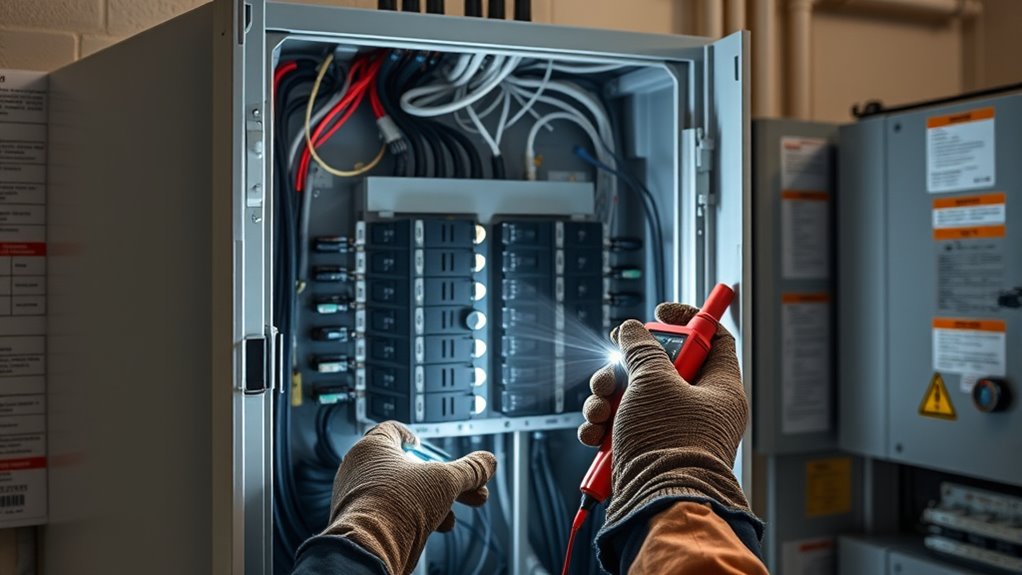
After an outage, verifying that your electrical system complies with current codes is essential for safety and reliability. First, inspect for grounding issues, ensuring all connections are secure and meet current standards to prevent electrical shocks or fire hazards. Second, evaluate your wiring; outdated wiring may require upgrades to handle modern power demands safely. Third, consult a licensed electrician to perform a thorough code compliance check, focusing on proper grounding and wiring integrity. Upgrading wiring and fixing grounding issues not only meets local regulations but also enhances safety and system performance. Regular post-outage assessments help identify potential problems early, reducing future risks and ensuring your electrical system remains safe and reliable.
Frequently Asked Questions
How Often Should I Schedule Professional Electrical Inspections?
You should schedule professional electrical inspections at least once every year to guarantee safety and proper functioning. Regular annual maintenance helps identify potential issues early, preventing costly repairs or hazards. Depending on your home’s age, electrical system complexity, or recent outages, you might need more frequent inspections. Stay proactive by adhering to recommended inspection frequency, and consider consulting a licensed electrician for personalized advice tailored to your specific electrical setup.
What Are Common Causes of Power Outages in Residential Areas?
Power outages in residential areas often happen due to storm damage, which can cause trees or debris to damage power lines, or utility maintenance, where crews work on infrastructure upgrades. Severe weather like storms and high winds can knock out power unexpectedly, while scheduled utility work might temporarily disrupt service. Being aware of these common causes helps you prepare and respond quickly, ensuring safety and minimizing inconvenience during outages.
Can I Use a Multimeter to Diagnose Electrical Issues?
Think of your multimeter as a trusty compass for electrical testing. Yes, you can use it to diagnose electrical issues, but make certain it’s properly calibrated first. Accurate multimeter calibration ensures reliable readings during electrical testing. When testing circuits, outlets, or wires, your multimeter helps identify faults or voltage problems. Just handle it carefully, follow safety tips, and double-check calibration to get precise results and avoid misdiagnosis.
What Should I Do if My Circuit Breaker Trips Repeatedly?
If your circuit breaker keeps tripping, it’s likely due to circuit overloads. First, identify and unplug devices causing excessive current. If the breaker continues to trip despite reducing load, consider replacing it, as it might be faulty. Always turn off the main power before replacing a breaker, and if you’re unsure, consult a professional electrician. This guarantees your electrical system stays safe and reliable.
Are There Specific Safety Gear Recommended for Electrical Inspections?
When performing electrical inspections, you should wear personal protective equipment like insulated gloves, safety goggles, and flame-resistant clothing to stay safe. Make sure to utilize proper inspection tools, such as voltage testers and insulated screwdrivers, to avoid accidental shocks. Always follow safety guidelines and double-check equipment condition before starting. Prioritizing your safety ensures you can identify issues effectively without risking injury.
Conclusion
After a power outage, taking these careful steps helps you stay ahead of potential issues and keeps your home running smoothly. By paying close attention and following safety guidelines, you can navigate the situation confidently. Remember, a little extra caution now can prevent bigger surprises later. Stay vigilant, and your electrical system will be back to its best in no time—keeping your home’s energy flowing quietly and securely.
